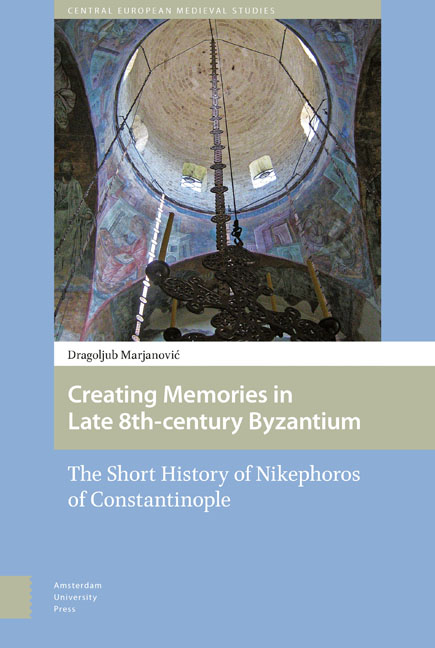Book contents
- Frontmatter
- Contents
- List of Tables
- Preface
- Introduction
- 1 Nikephoros the Layman
- 2 The Short History in the Byzantine Historiographical Tradition
- 3 Herakleios: Model of an Emperor
- 4 The Dark Century
- 5 Iconoclasts Restoring Order
- Conclusion: In Search of an Ideal Image of an Emperor
- Glossary
- Abbreviations
- Bibliography
- Index
Conclusion: In Search of an Ideal Image of an Emperor
Published online by Cambridge University Press: 11 December 2020
- Frontmatter
- Contents
- List of Tables
- Preface
- Introduction
- 1 Nikephoros the Layman
- 2 The Short History in the Byzantine Historiographical Tradition
- 3 Herakleios: Model of an Emperor
- 4 The Dark Century
- 5 Iconoclasts Restoring Order
- Conclusion: In Search of an Ideal Image of an Emperor
- Glossary
- Abbreviations
- Bibliography
- Index
Summary
In the context of narrativity, the Short History of Nikephoros of Constantinople is a multi-layered work. Our analysis was determined by our aim to explain its content in relation to the context in which it was written, given that Nikephoros himself had taken part in the events that shaped this very context. In the end, it seems to us that Nikephoros's work could offer additional new directions in research, depending on the ability of the researcher to ask new and original questions with regard to this significant source of Byzantine history writing at the end of the eighth and beginning of the ninth century.
The Short History of Nikephoros, with its specific content, manner of narration, and appropriate arrangement (which gives the text its particular structure), actually presents a specific source for the author's own epoch – the time of Nikephoros. Such a work equally tells us about the reigns of emperors Herakleios and Constantine V, and about Nikephoros's own understanding of the nature and role of the imperial office and its relationship to the institution of the patriarch. Nikephoros's personal ideas can be read in his portrayal of past events and historical personalities of the seventh and eighth centuries. As much as it might seem contradictory, by choosing to write about distant events, Nikephoros actually told us much about his own epoch and about history writing at the end of the eighth century. Strongly resounding in this work are those ideas which related to the events and processes that led the Church and the State into a new period after 787 – especially the ideas of the renewed autonomy and freedom of the Church. In such a cultural and political atmosphere, which the restored Orthodoxy established both in the Church and in the imperial palace – and Nikephoros was in position to observe these events from both perspectives – the Short History developed its specific content. Thus, the Short History took a nuanced and twofold glance at the position of the patriarch and his relation to the emperor, and looked also towards the character of successive imperial reigns, which had a direct effect on the state and the condition of the Roman empire.
Thus, Nikephoros's attitude towards the patriarchs of the Short History is rather multifaceted. His historical perspective is mostly directed towards the patriarchs of Constantinople, although they are incorporated into his narration of the imperial reigns of the period specified.
- Type
- Chapter
- Information
- Creating Memories in Late 8th-century ByzantiumThe Short History of Nikephoros of Constantinople, pp. 231 - 236Publisher: Amsterdam University PressPrint publication year: 2017



